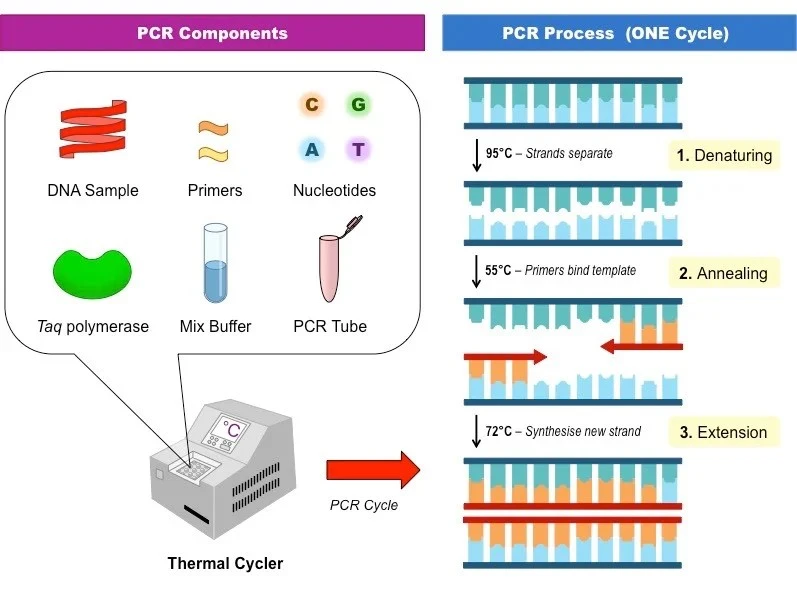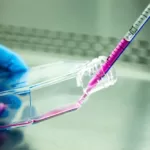Introduction:
Polymerase Chain Reaction (PCR) is an enzymatic process and an outstanding molecular biology technology that allows particular DNA sequences to be amplified. PCR, invented by Kary B. Mullis in 1983, has become a vital tool in a wide range of scientific areas, including genetics, forensics, medicine, and biotechnology. The method allows for the rapid replication of a specific DNA region, allowing for the generation of millions of copies from a small initial sample.
Principle of PCR:
The Polymerase Chain Reaction (PCR) is a commonly used nucleic acid amplification technology based on complementary nucleic acid hybridization and enzymatic replication principles. Through a series of cycles, this method can exponentially reproduce a given nucleic acid target, even when present at low amounts. PCR is useful for producing millions of copies (up to 107 or more) of a certain DNA sequence in a relatively short period of time.
The PCR technique is based on DNA replication that is aided by enzymes. DNA polymerase, which synthesizes new DNA strands complementary to the template DNA, is used to achieve primer-mediated DNA amplification. Because DNA polymerase can only add nucleotides to a 3′-OH group that already exists, a primer is required to start the process. Nucleotide addition occurs at the 3′ prime end of DNA polymerase, providing a recognizable location for several analytical approaches.
Required Components of PCR:
- DNA Template: The original DNA strand from which the target sequence will be amplified is referred to as the DNA template. It could be genomic DNA, cDNA, or plasmid DNA.
- Primers: Sequences of short, single-stranded DNA that are complementary to the target DNA region. They serve as DNA synthesis starting locations.
- DNA Polymerase: An enzyme that creates a new complementary DNA strand to the template strand. Taq polymerase, produced from the bacteria Thermus aquaticus, is widely employed due to its great at high temperatures.
- Nucleotides: The adenine, thymine, cytosine, and guanine building components of DNA are necessary for the creation of new DNA strands.
- Buffer Solution: A buffer solution maintains an ideal pH for DNA polymerase activity.
- Mg2+ ions: Magnesium ions (essential cofactor) are required for DNA polymerase activity.
Steps of PCR:
- Extraction and Denaturation of target nucleic acid
- Annealing
- Extension
- Cycling
- Final extension
- Final hold
- Analysis of product

Extraction and Denaturation of target nucleic acid
- The first step in nucleic acid amplification is to extract the target nucleic acid from the organism or a clinical sample that could include the target organism. To release the nucleic acid, this extraction technique can use heat, chemical, or enzymatic approaches.
- Following extraction, the isolated target nucleic acid is mixed with all of the polymerase chain reaction (PCR) components, such as primers, nucleotides, cofactors, buffers, and enzymes. This reaction mixture is then passed through a heat cycler to be amplified.
- The PCR reaction begins with denaturation, which involves heating the double-stranded DNA template to a high temperature, typically 94-98°C. This increased temperature allows hydrogen bonds between complementary bases to be broken, resulting in the separation of the two DNA strands.
Annealing:
- For around 20-40 seconds, the reaction temperature is reduced to 54-60°C. The primers attach to their complementary sequences on the template DNA at this point.
- Primers are single-stranded DNA or RNA sequences of 20 to 30 nucleotides in length.
- They act as the beginning point for DNA synthesis.
- Because the two separated strands run in different directions, there are two primers: a forward primer and a reverse primer.
| Forward primer | Reverse primer |
| The forward primer is a short, single-stranded DNA sequence that is complementary to one of the target DNA region’s strands. | The reverse primer is also a short, single-stranded DNA sequence, but it is designed to complement the target DNA’s opposite strand. |
| The “forward” primer is so named because it determines the 5′-3′ directionality of the recently synthesized DNA strand during PCR. | The “reverse” primer is named because it determines the 5′ to 3′ directionality of the recently synthesized DNA strand in the opposite direction compared to the forward primer. |
| The forward primer is normally intended to attach to the target DNA sequence’s upstream or 5′ end. | The reverse primer can be designed to attach to the target DNA sequence’s downstream or 3′ end. |
Extension:
- The temperature is raised to 72-80°C at this point. The Taq polymerase enzyme adds the nucleotides to the 3′ end of the primer.
- This causes the DNA to lengthen in the 5′ to 3′ direction. Under ideal conditions, the DNA polymerase adds roughly 1000bp each minute.
- Taq Polymerase can withstand extremely high temperatures. It binds to the primer and adds nucleotides to the single strand of DNA. As a result, a DNA molecule with two strands is formed.
- These three stages are performed 20-40 times to generate a large number of DNA sequences of interest in a short amount of time.
Cycling:
- One PCR cycle consists of the processes of denaturation, annealing, and extension.
- Multiple cycles occur to exponentially increase the target DNA. Each cycle causes the target DNA to double.

Final extension:
- Following the final cycle, a final extension step is frequently incorporated to ensure that any leftover single-stranded DNA is completely extended. This phase is usually performed at a slightly higher temperature for an extended period of time.
Final hold:
- To preserve the integrity of the amplified DNA and facilitate future analysis, the reaction is kept at a lower temperature (e.g., 4-15°C).
Analysis of Product:
- After that, the amplified DNA products are examined. Depending on the precise goals of the experiment, this can be accomplished using a variety of methodologies, such as gel electrophoresis or real-time PCR.
- Gel electrophoresis visualizes and confirms the existence and size of amplified DNA fragments, whereas real-time PCR quantifies amplified DNA during the PCR process.
Types of PCR:
Read In Detail: 36 Types of PCR You Must Know
- Conventional PCR:
- Real-Time PCR (qPCR):
- Reverse Transcription PCR (RT-PCR):
- Nested PCR:
- Multiplex PCR:
- Hot Start PCR:
- Long-Range PCR:
- High-Fidelity PCR:
- Overlap Extension PCR (Splicing by Overlapping Extension – SOE-PCR):
- Inverse PCR:
- Droplet Digital PCR (ddPCR):
- Methylation-Specific PCR (MSP):
Application of PCR:
- PCR can amplify a single DNA molecule from a complicated mixture, largely eliminating the requirement for DNA cloning. Similarly, variants of the approach can amplify a single RNA molecule from a complex mixture.
- PCR has substantially simplified DNA sequencing, and this application is now widely used.
- PCR can be used to create point mutations, deletions, and insertions of target DNA by using appropriate primers, considerably facilitating the investigation of gene expression and function.
- PCR is extremely sensitive and may amplify minuscule amounts of DNA. Thus, very little levels of certain bacteria and viruses can be detected in tissues using proper primers, making PCR invaluable for medical diagnosis.
- PCR is currently an indispensable tool for characterizing medically significant DNA material. For example, it is increasingly replacing the use of RFLPs in screening for human genetic disorders.
- PCR is now critically significant in forensic medicine due of its great sensitivity. PCR can even be used to amplify DNA from a single human hair or a minuscule drop of blood left at the scene of a crime, allowing for thorough characterization.
Sources and references:
- David Hames and Nigel Hooper (2005). Biochemistry. Third ed. Taylor & Francis Group: New York.
- Bailey, W. R., Scott, E. G., Finegold, S. M., & Baron, E. J. (1986). Bailey and Scott’s Diagnostic Microbiology. St. Louis: Mosby.
- Sastry A.S. & Bhat S.K. (2016). Essentials of Medical Microbiology. New Delhi : Jaypee Brothers Medical Publishers.
- https://en.wikipedia.org/wiki/Polymerase_chain_reaction





